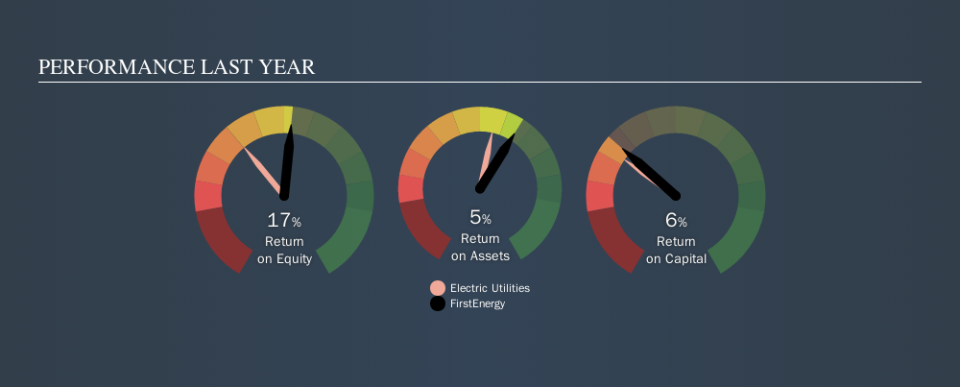Should You Like FirstEnergy Corp.’s (NYSE:FE) High Return On Capital Employed?

Today we'll look at FirstEnergy Corp. (NYSE:FE) and reflect on its potential as an investment. To be precise, we'll consider its Return On Capital Employed (ROCE), as that will inform our view of the quality of the business.
First, we'll go over how we calculate ROCE. Next, we'll compare it to others in its industry. Then we'll determine how its current liabilities are affecting its ROCE.
What is Return On Capital Employed (ROCE)?
ROCE is a metric for evaluating how much pre-tax income (in percentage terms) a company earns on the capital invested in its business. In general, businesses with a higher ROCE are usually better quality. Ultimately, it is a useful but imperfect metric. Author Edwin Whiting says to be careful when comparing the ROCE of different businesses, since 'No two businesses are exactly alike.'
How Do You Calculate Return On Capital Employed?
The formula for calculating the return on capital employed is:
Return on Capital Employed = Earnings Before Interest and Tax (EBIT) ÷ (Total Assets - Current Liabilities)
Or for FirstEnergy:
0.062 = US$2.3b ÷ (US$41b - US$4.0b) (Based on the trailing twelve months to June 2019.)
So, FirstEnergy has an ROCE of 6.2%.
Check out our latest analysis for FirstEnergy
Is FirstEnergy's ROCE Good?
ROCE can be useful when making comparisons, such as between similar companies. In our analysis, FirstEnergy's ROCE is meaningfully higher than the 4.9% average in the Electric Utilities industry. We would consider this a positive, as it suggests it is using capital more effectively than other similar companies. Setting aside the industry comparison for now, FirstEnergy's ROCE is mediocre in absolute terms, considering the risk of investing in stocks versus the safety of a bank account. Investors may wish to consider higher-performing investments.
You can click on the image below to see (in greater detail) how FirstEnergy's past growth compares to other companies.
It is important to remember that ROCE shows past performance, and is not necessarily predictive. Companies in cyclical industries can be difficult to understand using ROCE, as returns typically look high during boom times, and low during busts. This is because ROCE only looks at one year, instead of considering returns across a whole cycle. Future performance is what matters, and you can see analyst predictions in our free report on analyst forecasts for the company.
What Are Current Liabilities, And How Do They Affect FirstEnergy's ROCE?
Short term (or current) liabilities, are things like supplier invoices, overdrafts, or tax bills that need to be paid within 12 months. Due to the way ROCE is calculated, a high level of current liabilities makes a company look as though it has less capital employed, and thus can (sometimes unfairly) boost the ROCE. To counter this, investors can check if a company has high current liabilities relative to total assets.
FirstEnergy has total assets of US$41b and current liabilities of US$4.0b. Therefore its current liabilities are equivalent to approximately 9.7% of its total assets. With low levels of current liabilities, at least FirstEnergy's mediocre ROCE is not unduly boosted.
The Bottom Line On FirstEnergy's ROCE
Based on this information, FirstEnergy appears to be a mediocre business. Of course, you might also be able to find a better stock than FirstEnergy. So you may wish to see this free collection of other companies that have grown earnings strongly.
If you are like me, then you will not want to miss this free list of growing companies that insiders are buying.
We aim to bring you long-term focused research analysis driven by fundamental data. Note that our analysis may not factor in the latest price-sensitive company announcements or qualitative material.
If you spot an error that warrants correction, please contact the editor at editorial-team@simplywallst.com. This article by Simply Wall St is general in nature. It does not constitute a recommendation to buy or sell any stock, and does not take account of your objectives, or your financial situation. Simply Wall St has no position in the stocks mentioned. Thank you for reading.

 Yahoo Finance
Yahoo Finance 
